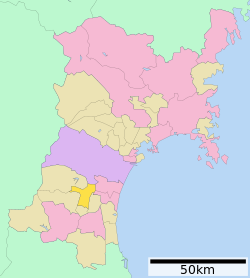Murata, Miyagi
|
Murata 村田町 |
|||
|---|---|---|---|
| Town | |||

Murata Town Office
|
|||
|
|||
 Location of Murata in Miyagi Prefecture |
|||
| Coordinates: 38°07′08″N 140°43′16″E / 38.11889°N 140.72111°ECoordinates: 38°07′08″N 140°43′16″E / 38.11889°N 140.72111°E | |||
| Country | Japan | ||
| Region | Tōhoku | ||
| Prefecture | Miyagi | ||
| District | Shibata | ||
| Area | |||
| • Total | 78.38 km2 (30.26 sq mi) | ||
| Population (September 2015) | |||
| • Total | 11,366 | ||
| • Density | 145/km2 (380/sq mi) | ||
| Time zone | Japan Standard Time (UTC+9) | ||
| City symbols | |||
| • Tree | Pine | ||
| • Flower | Osmanthus fragrans | ||
| • Bird | Green pheasant | ||
| Phone number | 0224-83-2111 | ||
| Address | Murata-machi, Shibata-gun, Miyagi-ken 989-1392 | ||
| Website | Official website | ||
Murata (村田町 Murata-machi?) is a town located in Shibata District, Miyagi Prefecture, in the Tohoku region of northern Japan. As of September 2015, the town had an estimated population of 11,366 and a population density of 145 persons per km2. The total area was 78.38 square kilometres (30.26 sq mi).
Murata is located in south-central Miyagi Prefecture. The Shiroishi River runs through the town.
The area of present-day Murata was part of ancient Mutsu Province. The modern village of Murata was established on April 1, 1889 with the creation of the municipalities system. It was promoted to town status on October 31, 1895. The town merged with the neighboring towns on Tomioka and Numabe on April 20, 1955.
The economy of Murata is largely based on agriculture.
Murata has two elementary schools, two middle schools and one high school.
...
Wikipedia


